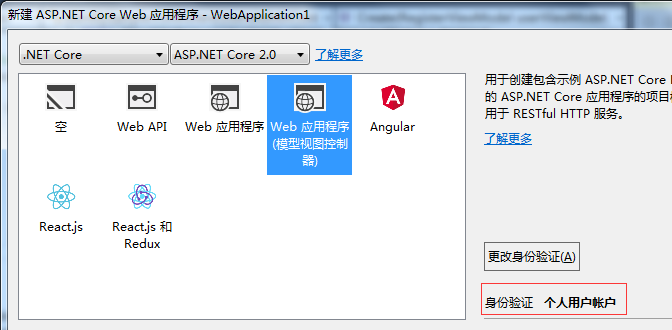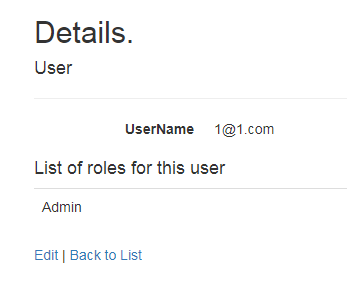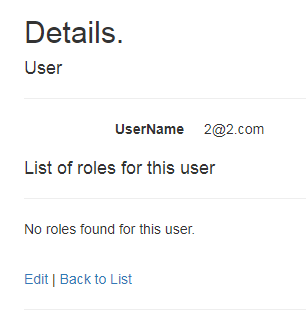asp.net core web 添加角色管理
新建asp.net core web应用

添加RolesAdminController
[Authorize(Roles = "Admin")]
public class RolesAdminController : Controller
{
private UserManager<ApplicationUser> _userManager;
private RoleManager<IdentityRole> _roleManager;
private readonly ILogger _logger;
public RolesAdminController(UserManager<ApplicationUser> userManager, RoleManager<IdentityRole> roleManager, ILogger<AccountController> logger)
{
_userManager = userManager;
_roleManager = roleManager;
_logger = logger;
}
//
// GET: /Roles/
public ActionResult Index()
{
return View(_roleManager.Roles);
}
//
// GET: /Roles/Details/5
public async Task<ActionResult> Details(string id)
{
if (id == null)
{
throw new ApplicationException();
}
var role = await _roleManager.FindByIdAsync(id);
// Get the list of Users in this Role
var users = new List<ApplicationUser>();
// Get the list of Users in this Role
foreach (var user in _userManager.Users.ToList())
{
if (await _userManager.IsInRoleAsync(user, role.Name))
{
users.Add(user);
}
}
ViewBag.Users = users;
ViewBag.UserCount = users.Count();
return View(role);
}
//
// GET: /Roles/Create
public ActionResult Create()
{
return View();
}
//
// POST: /Roles/Create
[HttpPost]
public async Task<ActionResult> Create(IdentityRole roleViewModel)
{
if (ModelState.IsValid)
{
var role = new IdentityRole(roleViewModel.Name);
var roleresult = await _roleManager.CreateAsync(role);
if (!roleresult.Succeeded)
{
AddErrors(roleresult);
return View();
}
return RedirectToAction("Index");
}
return View();
}
//
// GET: /Roles/Edit/Admin
public async Task<ActionResult> Edit(string id)
{
if (id == null)
{
throw new ApplicationException();
}
var role = await _roleManager.FindByIdAsync(id);
if (role == null)
{
throw new ApplicationException();
}
IdentityRole roleModel = new IdentityRole { Id = role.Id, Name = role.Name };
return View(roleModel);
}
[HttpPost]
[ValidateAntiForgeryToken]
public async Task<ActionResult> Edit(IdentityRole roleModel)
{
if (ModelState.IsValid)
{
var role = await _roleManager.FindByIdAsync(roleModel.Id);
role.Name = roleModel.Name;
await _roleManager.UpdateAsync(role);
return RedirectToAction("Index");
}
return View();
}
//
// GET: /Roles/Delete/5
public async Task<ActionResult> Delete(string id)
{
if (id == null)
{
throw new ApplicationException();
}
var role = await _roleManager.FindByIdAsync(id);
if (role == null)
{
throw new ApplicationException();
}
return View(role);
}
//
// POST: /Roles/Delete/5
[HttpPost, ActionName("Delete")]
[ValidateAntiForgeryToken]
public async Task<ActionResult> DeleteConfirmed(string id, string deleteUser)
{
if (ModelState.IsValid)
{
if (id == null)
{
throw new ApplicationException();
}
var role = await _roleManager.FindByIdAsync(id);
if (role == null)
{
throw new ApplicationException();
}
IdentityResult result;
if (deleteUser != null)
{
result = await _roleManager.DeleteAsync(role);
}
else
{
result = await _roleManager.DeleteAsync(role);
}
if (!result.Succeeded)
{
AddErrors(result);
return View();
}
return RedirectToAction("Index");
}
return View();
}
#region Helpers
private void AddErrors(IdentityResult result)
{
foreach (var error in result.Errors)
{
ModelState.AddModelError(string.Empty, error.Description);
}
}
private IActionResult RedirectToLocal(string returnUrl)
{
if (Url.IsLocalUrl(returnUrl))
{
return Redirect(returnUrl);
}
else
{
return RedirectToAction(nameof(HomeController.Index), "Home");
}
}
#endregion
}
添加对应的View
index
@model IEnumerable<IdentityRole>
@{
ViewBag.Title = "Index";
}
<h2>Index</h2>
<p>
@Html.ActionLink("Create New", "Create")
</p>
<table class="table">
<tr>
<th>
@Html.DisplayNameFor(model => model.Name)
</th>
<th>
</th>
</tr>
@foreach (var item in Model)
{
<tr>
<td>
@Html.DisplayFor(modelItem => item.Name)
</td>
<td>
@Html.ActionLink("Edit", "Edit", new { id = item.Id }) |
@Html.ActionLink("Details", "Details", new { id = item.Id }) |
@Html.ActionLink("Delete", "Delete", new { id = item.Id })
</td>
</tr>
}
</table>
create
@model IdentityRole
@{
ViewBag.Title = "Create";
}
<h2>Create.</h2>
@using (Html.BeginForm())
{
@Html.AntiForgeryToken()
<div class="form-horizontal">
<h4>Role.</h4>
<hr />
@Html.ValidationSummary(true)
<div class="form-group">
@Html.LabelFor(model => model.Name, new { @class = "control-label col-md-2" })
<div class="col-md-10">
@Html.TextBoxFor(model => model.Name, new { @class = "form-control" })
@Html.ValidationMessageFor(model => model.Name)
</div>
</div>
<div class="form-group">
<div class="col-md-offset-2 col-md-10">
<input type="submit" value="Create" class="btn btn-default" />
</div>
</div>
</div>
}
<div>
@Html.ActionLink("Back to List", "Index")
</div>
@section Scripts {
@await Html.PartialAsync("_ValidationScriptsPartial")
}
edit
@model IdentityRole
@{
ViewBag.Title = "Edit";
}
<h2>Edit.</h2>
@using (Html.BeginForm())
{
@Html.AntiForgeryToken()
<div class="form-horizontal">
<h4>Roles.</h4>
<hr />
@Html.ValidationSummary(true)
@Html.HiddenFor(model => model.Id)
<div class="form-group">
@Html.LabelFor(model => model.Name, new { @class = "control-label col-md-2" })
<div class="col-md-10">
@Html.TextBoxFor(model => model.Name, new { @class = "form-control" })
@Html.ValidationMessageFor(model => model.Name)
</div>
</div>
<div class="form-group">
<div class="col-md-offset-2 col-md-10">
<input type="submit" value="Save" class="btn btn-default" />
</div>
</div>
</div>
}
<div>
@Html.ActionLink("Back to List", "Index")
</div>
@section Scripts {
@await Html.PartialAsync("_ValidationScriptsPartial")
}
details
@model IdentityRole
@{
ViewBag.Title = "Details";
}
<h2>Role Details.</h2>
<div>
<h4>Roles.</h4>
<hr />
<dl class="dl-horizontal">
<dt>
@Html.DisplayNameFor(model => model.Name)
</dt>
<dd>
@Html.DisplayFor(model => model.Name)
</dd>
</dl>
</div>
<h4>List of users in this role</h4>
@if (ViewBag.UserCount == )
{
<hr />
<p>No users found in this role.</p>
}
<table class="table">
@foreach (var item in ViewBag.Users)
{
<tr>
<td>
@item.UserName
</td>
</tr>
}
</table>
<p>
@Html.ActionLink("Edit", "Edit", new { id = Model.Id }) |
@Html.ActionLink("Back to List", "Index")
</p>
delete
@model IdentityRole
@{
ViewBag.Title = "Delete";
}
<h2>Delete.</h2>
<h3>Are you sure you want to delete this Role? </h3>
<p>Deleting this Role will remove all users from this role. It will not delete the users.</p>
<div>
<h4>Delete Role.</h4>
<hr />
<dl class="dl-horizontal">
<dt>
@Html.DisplayNameFor(model => model.Name)
</dt>
<dd>
@Html.DisplayFor(model => model.Name)
</dd>
</dl>
@using (Html.BeginForm())
{
@Html.AntiForgeryToken()
<div class="form-actions no-color">
<input type="submit" value="Delete" class="btn btn-default" /> |
@Html.ActionLink("Back to List", "Index")
</div>
}
</div>
添加UsersAdminController
[Authorize(Roles = "Admin")]
public class UsersAdminController : Controller
{
public UsersAdminController(UserManager<ApplicationUser> userManager, RoleManager<IdentityRole> roleManager, ILogger<AccountController> logger)
{
_userManager = userManager;
_roleManager = roleManager;
_logger = logger;
}
private UserManager<ApplicationUser> _userManager;
private RoleManager<IdentityRole> _roleManager;
private readonly ILogger _logger;
//
// GET: /Users/
public async Task<ActionResult> Index()
{
return View(await _userManager.Users.ToListAsync());
}
//
// GET: /Users/Details/5
public async Task<ActionResult> Details(string id)
{
if (id == null)
{
throw new ApplicationException();
}
var user = await _userManager.FindByIdAsync(id);
ViewBag.RoleNames = await _userManager.GetRolesAsync(user);
return View(user);
}
//
// GET: /Users/Create
public async Task<ActionResult> Create()
{
//Get the list of Roles
ViewBag.RoleId = new SelectList(await _roleManager.Roles.ToListAsync(), "Name", "Name");
return View();
}
//
// POST: /Users/Create
[HttpPost]
public async Task<ActionResult> Create(RegisterViewModel userViewModel, params string[] selectedRoles)
{
if (ModelState.IsValid)
{
var user = new ApplicationUser
{
UserName = userViewModel.Email,
Email =
userViewModel.Email,
};
// Then create:
var adminresult = await _userManager.CreateAsync(user, userViewModel.Password);
//Add User to the selected Roles
if (adminresult.Succeeded)
{
if (selectedRoles != null)
{
var result = await _userManager.AddToRolesAsync(user, selectedRoles);
if (!result.Succeeded)
{
AddErrors(result);
ViewBag.RoleId = new SelectList(await _roleManager.Roles.ToListAsync(), "Name", "Name");
return View();
}
}
}
else
{
AddErrors(adminresult);
ViewBag.RoleId = new SelectList(_roleManager.Roles, "Name", "Name");
return View();
}
return RedirectToAction("Index");
}
ViewBag.RoleId = new SelectList(_roleManager.Roles, "Name", "Name");
return View();
}
//
// GET: /Users/Edit/1
public async Task<ActionResult> Edit(string id)
{
if (id == null)
{
throw new ApplicationException();
}
var user = await _userManager.FindByIdAsync(id);
if (user == null)
{
throw new ApplicationException();
}
var userRoles = await _userManager.GetRolesAsync(user);
return View(new EditUserViewModel()
{
Id = user.Id,
Email = user.Email,
RolesList = _roleManager.Roles.ToList().Select(x => new SelectListItem()
{
Selected = userRoles.Contains(x.Name),
Text = x.Name,
Value = x.Name
})
});
}
//
// POST: /Users/Edit/5
[HttpPost]
[ValidateAntiForgeryToken]
public async Task<ActionResult> Edit(EditUserViewModel editUser, params string[] selectedRole)
{
if (ModelState.IsValid)
{
var user = await _userManager.FindByIdAsync(editUser.Id);
if (user == null)
{
throw new ApplicationException();
}
user.UserName = editUser.Email;
user.Email = editUser.Email;
var userRoles = await _userManager.GetRolesAsync(user);
selectedRole = selectedRole ?? new string[] { };
var result = await _userManager.AddToRolesAsync(user, selectedRole.Except(userRoles).ToArray<string>());
if (!result.Succeeded)
{
AddErrors(result);
return View();
}
result = await _userManager.RemoveFromRolesAsync(user, userRoles.Except(selectedRole).ToArray<string>());
if (!result.Succeeded)
{
AddErrors(result);
return View();
}
return RedirectToAction("Index");
}
ModelState.AddModelError("", "Something failed.");
return View();
}
//
// GET: /Users/Delete/5
public async Task<ActionResult> Delete(string id)
{
if (id == null)
{
throw new ApplicationException();
}
var user = await _userManager.FindByIdAsync(id);
if (user == null)
{
throw new ApplicationException();
}
return View(user);
}
//
// POST: /Users/Delete/5
[HttpPost, ActionName("Delete")]
[ValidateAntiForgeryToken]
public async Task<ActionResult> DeleteConfirmed(string id)
{
if (ModelState.IsValid)
{
if (id == null)
{
throw new ApplicationException();
}
var user = await _userManager.FindByIdAsync(id);
if (user == null)
{
throw new ApplicationException();
}
var result = await _userManager.DeleteAsync(user);
if (!result.Succeeded)
{
AddErrors(result);
return View();
}
return RedirectToAction("Index");
}
return View();
}
#region Helpers
private void AddErrors(IdentityResult result)
{
foreach (var error in result.Errors)
{
ModelState.AddModelError(string.Empty, error.Description);
}
}
private IActionResult RedirectToLocal(string returnUrl)
{
if (Url.IsLocalUrl(returnUrl))
{
return Redirect(returnUrl);
}
else
{
return RedirectToAction(nameof(HomeController.Index), "Home");
}
}
#endregion
}
添加对应的EditUserViewModel
public class EditUserViewModel
{
public string Id { get; set; }
[Required(AllowEmptyStrings = false)]
[Display(Name = "Email")]
[EmailAddress]
public string Email { get; set; }
public IEnumerable<SelectListItem> RolesList { get; set; }
}
添加对应的view
index
@model IEnumerable<WebApplication2.Models.ApplicationUser>
@{
ViewBag.Title = "Index";
}
<h2>Index</h2>
<p>
@Html.ActionLink("Create New", "Create")
</p>
<table class="table">
<tr>
<th>
@Html.DisplayNameFor(model => model.UserName)
</th>
<th>
</th>
</tr>
@foreach (var item in Model)
{
<tr>
<td>
@Html.DisplayFor(modelItem => item.UserName)
</td>
<td>
@Html.ActionLink("Edit", "Edit", new { id = item.Id }) |
@Html.ActionLink("Details", "Details", new { id = item.Id }) |
@Html.ActionLink("Delete", "Delete", new { id = item.Id })
</td>
</tr>
}
</table>
create
@model WebApplication2.Models.AccountViewModels.RegisterViewModel
@{
ViewBag.Title = "Create";
}
<h2>@ViewBag.Title.</h2>
@using (Html.BeginForm("Create", "UsersAdmin", FormMethod.Post, new { @class = "form-horizontal", role = "form" }))
{
@Html.AntiForgeryToken()
<h4>Create a new account.</h4>
<hr />
@Html.ValidationSummary("", new { @class = "text-error" })
<div class="form-group">
@Html.LabelFor(m => m.Email, new { @class = "col-md-2 control-label" })
<div class="col-md-10">
@Html.TextBoxFor(m => m.Email, new { @class = "form-control" })
</div>
</div>
<div class="form-group">
@Html.LabelFor(m => m.Password, new { @class = "col-md-2 control-label" })
<div class="col-md-10">
@Html.PasswordFor(m => m.Password, new { @class = "form-control" })
</div>
</div>
<div class="form-group">
@Html.LabelFor(m => m.ConfirmPassword, new { @class = "col-md-2 control-label" })
<div class="col-md-10">
@Html.PasswordFor(m => m.ConfirmPassword, new { @class = "form-control" })
</div>
</div>
<div class="form-group">
<label class="col-md-2 control-label">
Select User Role
</label>
<div class="col-md-10">
@foreach (var item in (SelectList)ViewBag.RoleId)
{
<input type="checkbox" name="SelectedRoles" value="@item.Value" class="checkbox-inline" />
@Html.Label("Role", item.Value, new { @class = "control-label" })
}
</div>
</div>
<div class="form-group">
<div class="col-md-offset-2 col-md-10">
<input type="submit" class="btn btn-default" value="Create" />
</div>
</div>
}
@section Scripts {
@await Html.PartialAsync("_ValidationScriptsPartial")
}
edit
@model WebApplication2.Models.AdminViewModels.EditUserViewModel
@{
ViewBag.Title = "Edit";
}
<h2>Edit.</h2>
@using (Html.BeginForm())
{
@Html.AntiForgeryToken()
<div class="form-horizontal">
<h4>Edit User Form.</h4>
<hr />
@Html.ValidationSummary(true)
@Html.HiddenFor(model => model.Id)
<div class="form-group">
@Html.LabelFor(model => model.Email, new { @class = "control-label col-md-2" })
<div class="col-md-10">
@Html.TextBoxFor(m => m.Email, new { @class = "form-control" })
@Html.ValidationMessageFor(model => model.Email)
</div>
</div>
<div class="form-group">
@Html.Label("Roles","", new { @class = "control-label col-md-2" })
<span class=" col-md-10">
@foreach (var item in Model.RolesList)
{
<input type="checkbox" name="SelectedRole" value="@item.Value" checked="@item.Selected" class="checkbox-inline" />
@Html.Label("Role",item.Value, new { @class = "control-label" })
}
</span>
</div>
<div class="form-group">
<div class="col-md-offset-2 col-md-10">
<input type="submit" value="Save" class="btn btn-default" />
</div>
</div>
</div>
}
<div>
@Html.ActionLink("Back to List", "Index")
</div>
@section Scripts {
@await Html.PartialAsync("_ValidationScriptsPartial")
}
details
@model WebApplication2.Models.ApplicationUser
@{
ViewBag.Title = "Details";
}
<h2>Details.</h2>
<div>
<h4>User</h4>
<hr />
<dl class="dl-horizontal">
<dt>
@Html.DisplayNameFor(model => model.UserName)
</dt>
<dd>
@Html.DisplayFor(model => model.UserName)
</dd>
</dl>
</div>
<h4>List of roles for this user</h4>
@if (ViewBag.RoleNames.Count == )
{
<hr />
<p>No roles found for this user.</p>
}
<table class="table">
@foreach (var item in ViewBag.RoleNames)
{
<tr>
<td>
@item
</td>
</tr>
}
</table>
<p>
@Html.ActionLink("Edit", "Edit", new { id = Model.Id }) |
@Html.ActionLink("Back to List", "Index")
</p>
delete
@model WebApplication2.Models.ApplicationUser
@{
ViewBag.Title = "Delete";
}
<h2>Delete.</h2>
<h3>Are you sure you want to delete this User?</h3>
<div>
<h4>User.</h4>
<hr />
<dl class="dl-horizontal">
<dt>
@Html.DisplayNameFor(model => model.UserName)
</dt>
<dd>
@Html.DisplayFor(model => model.UserName)
</dd>
</dl>
@using (Html.BeginForm()) {
@Html.AntiForgeryToken()
<div class="form-actions no-color">
<input type="submit" value="Delete" class="btn btn-default" /> |
@Html.ActionLink("Back to List", "Index")
</div>
}
</div>
修改共享模板页
Shared/_layout.cshtml
<div class="navbar-collapse collapse">
<ul class="nav navbar-nav">
<li><a asp-area="" asp-controller="Home" asp-action="Index">Home</a></li>
<li><a asp-area="" asp-controller="Home" asp-action="About">About</a></li>
<li><a asp-area="" asp-controller="Home" asp-action="Contact">Contact</a></li>
@if (User!=null && User.IsInRole("Admin"))
{
<li>@Html.ActionLink("RolesAdmin", "Index", "RolesAdmin")</li>
<li>@Html.ActionLink("UsersAdmin", "Index", "UsersAdmin")</li>
}
</ul>
@await Html.PartialAsync("_LoginPartial")
</div>
运行应用,注册两个账号

1@1.com具有Admin角色权限

2@2.com没有 Admin权限

1@1.com可以进入管理页面

2@2.com没有管理页面权限

Role具体实现
UserManager<TUser>类中的IsInRoleAsync(user, role.Name)是个虚方法
public virtual Task<bool> IsInRoleAsync(TUser user, string role);
具体的实现是在Microsoft.AspNet.Identity.EntityFramework 中,使用dotPeek 打开Microsoft.AspNet.Identity.EntityFramework.dll

public virtual async Task<bool> IsInRoleAsync(TUser user, string roleName)
{
this.ThrowIfDisposed();
if ((object) user == null)
throw new ArgumentNullException(nameof (user));
if (string.IsNullOrWhiteSpace(roleName))
throw new ArgumentException(IdentityResources.ValueCannotBeNullOrEmpty, nameof (roleName));
TRole role = (TRole) await (TaskExtensions.CultureAwaiter<TRole>) TaskExtensions.WithCurrentCulture<TRole>(QueryableExtensions.SingleOrDefaultAsync<TRole>((IQueryable<M0>) this._roleStore.DbEntitySet, (Expression<Func<M0, bool>>) (r => r.Name.ToUpper() == roleName.ToUpper())));
if ((object) role == null)
return false;
TKey userId = user.Id;
TKey roleId = role.Id;
;
}
可以看到判断的依旧是r => r.Name.ToUpper() == roleName.ToUpper()
自定义用户、角色属性
参考:ASP.NET Identity 2.0: Customizing Users and Roles
这里需要修改几处
创建ApplicationRole
public class ApplicationRole:IdentityRole
{
public ApplicationRole() : base() { }
public ApplicationRole(string roleName) : base(roleName) { }
}
修改RolesAdminController和UsersAdminController
将之前的IdentityRole替换成ApplicationRole
修改ApplicationDbContext,加上新建的ApplicationRole及TKey--string
public class ApplicationDbContext : IdentityDbContext<ApplicationUser, ApplicationRole,string>
修改Startup中的ConfigureServices
services.AddIdentity<ApplicationUser, ApplicationRole>()
.AddEntityFrameworkStores<ApplicationDbContext>()
.AddDefaultTokenProviders();
重新运行项目即可
接下来就可以在ApplicationUser和ApplicationRole中添加属性
public class ApplicationRole:IdentityRole
{
public ApplicationRole() : base() { }
public ApplicationRole(string roleName) : base(roleName) { }
public string Description { get; set; }
}
之后更新对应的ViewModel和页面即可。
asp.net core web 添加角色管理的更多相关文章
- ASP.NET Core Web API下事件驱动型架构的实现(二):事件处理器中对象生命周期的管理
在上文中,我介绍了事件驱动型架构的一种简单的实现,并演示了一个完整的事件派发.订阅和处理的流程.这种实现太简单了,百十行代码就展示了一个基本工作原理.然而,要将这样的解决方案运用到实际生产环境,还有很 ...
- asp.net core web api + Element-UI的Vue管理后台
后端:asp.net core web api + EF Core 前端:VUE + Element-UI+ Node环境的后台管理系统. 线上地址:http://www.wangjk.wang/ 密 ...
- ASP.NET Core Web API下事件驱动型架构的实现(一):一个简单的实现
很长一段时间以来,我都在思考如何在ASP.NET Core的框架下,实现一套完整的事件驱动型架构.这个问题看上去有点大,其实主要目标是为了实现一个基于ASP.NET Core的微服务,它能够非常简单地 ...
- 使用JWT创建安全的ASP.NET Core Web API
在本文中,你将学习如何在ASP.NET Core Web API中使用JWT身份验证.我将在编写代码时逐步简化.我们将构建两个终结点,一个用于客户登录,另一个用于获取客户订单.这些api将连接到在本地 ...
- Azure 部署 Asp.NET Core Web App
在云计算大行其道的时代,当你在部署一个网站时,第一选择肯定是各式各样的云端服务.那么究竟使用什么样的云端服务才能够以最快捷的方式部署一个 ASP.NET Core 的网站呢?Azure 的 Web A ...
- 使用 Swagger 自动生成 ASP.NET Core Web API 的文档、在线帮助测试文档(ASP.NET Core Web API 自动生成文档)
对于开发人员来说,构建一个消费应用程序时去了解各种各样的 API 是一个巨大的挑战.在你的 Web API 项目中使用 Swagger 的 .NET Core 封装 Swashbuckle 可以帮助你 ...
- Gitlab CI 自动部署 asp.net core web api 到Docker容器
为什么要写这个? 在一个系统长大的过程中会经历不断重构升级来满足商业的需求,而一个严谨的商业系统需要高效.稳定.可扩展,有时候还不得不考虑成本的问题.我希望能找到比较完整的开源解决方案来解决持续集成. ...
- ASP.NET Core Web 支付功能接入 支付宝-电脑网页支付篇
这篇文章将介绍ASP.NET Core中使用 开源项目 Payment,实现接入支付宝-电脑网页支付接口及同步跳转及异步通知功能. 开发环境:Win 10 x64.VS2017 15.6.4..NET ...
- ASP.NET Core Web 支付功能接入 微信-扫码支付篇
这篇文章将介绍ASP.NET Core中使用 开源项目 Payment,实现接入微信-扫码支付及异步通知功能. 开发环境:Win 10 x64.VS2017 15.6.4..NET Core SDK ...
随机推荐
- RGB,YCBCR在HDMI传输线是数据排列
RGB4:4:4 YCbCr4:4:4 YCbCr4:2:2 YCbCr4:2:0
- Angularjs的directive封装ztree
一般我们做web开发都会用到树,恰好ztree为我们提供了多种风格的树插件. 接下来就看看怎么用Angularjs的directive封装ztree <!DOCTYPE html> < ...
- 阿里云对象存储oss上传文件夹
最近公司做工程项目,实现文件夹云存储上传. 网上找了一天,发现网上很多代码都存在相似问题,最后终于找到了一个满足我需求的项目. 工程如下: 这里对项目的大文件传输功能做出分析,怎么实现文件夹上传的,如 ...
- share pool 管理机制
Library cache是Shared pool的一部分,它几乎是Oracle内存结构中最复杂的一部分,主要存放shared curosr(SQL)和PLSQL对象(function,procedu ...
- 适配android和iOS上position:absolute和input问题
//适配android上absolute和input的问题var oHeight = $(document).height(); //屏幕当前的高度$(window).resize(function( ...
- 20145232 韩文浩 《Java程序设计》第6周学习总结
教材学习内容总结 Java是以串流(Stream)的方式来处理输入与输出. 串流是一种抽象观念,从键盘输入资料,将处理结果输入档案,以及读取档案的内容等动作皆视为串流的处理. 输入串流代表对象为jav ...
- 中国移动物联网平台数据转发 c# 控制台程序
using System; using System.Collections.Generic; using System.Linq; using System.Text; using System.N ...
- python编写producer、consumer
自主producer.consumer 首先在不同的终端,分别开启两个consumer,保证groupid一致 ]# python consumer_kafka.py 执行一次producer ]# ...
- Mining Twitter Data with Python
目录 1.Collecting data 1.1 Register Your App 1.2 Accessing the Data 1.3 Streaming 2.Text Pre-processin ...
- 【计算机网络】TCP通信的细节及TCP连接对HTTP事务处理性能影响
从三次握手的细节说起 刚开始尝试使用java等后端语言写IO流,或用套接字(socket)实现简单C/S通信的同学们,常常会接触到的一个概念:就是所谓的“三次握手”,socket作为一个API接口,封 ...
